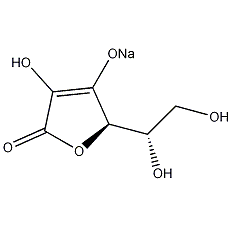
Structural formula
| Business number | 03PB |
|---|---|
| Molecular formula | C6H7NaO6 |
| Molecular weight | 198.10 |
| label |
sodium ascorbate, L(+)-Ascorbic acid sodium salt, Vitamin C sodium salt, Antioxidants |
Numbering system
CAS number:134-03-2
MDL number:MFCD00082340
EINECS number:205-126-1
RTECS number:CI7671000
BRN number:3767246
PubChem number:24891261
Physical property data
1. Properties: White fine crystals.
2. Density (g/mL, 25/4℃): Undetermined
3. Relative vapor density (g/mL, air=1): Undetermined
4. Melting point (ºC): 218 (decomposition)
5. Boiling point (ºC, normal pressure): Undetermined
6. Boiling point (ºC, 5.2kPa) : Undetermined
7. Refractive index: Undetermined
8. Flash point (ºC): Undetermined
9. Specific rotation (º): [a]20/D+104.4°(in water)
10. Autoignition point or ignition temperature (ºC): Undetermined
11. Vapor pressure (kPa, 25ºC) : Undetermined
12. Saturated vapor pressure (kPa, 60ºC): Undetermined
13. Heat of combustion (KJ/mol): Undetermined
14 . Critical temperature (ºC): Undetermined
15. Critical pressure (KPa): Undetermined
16. Log value of oil-water (octanol/water) partition coefficient: Undetermined
17. Explosion upper limit (%, V/V): Undetermined
18. Explosion lower limit (%, V/V): Undetermined
19 . Solubility: Easily soluble in water. Its aqueous solution is unstable when pH>6 and is quickly oxidized by air. Ascorbic acid solution can be added as a buffer to lower the pH and improve stability.
Toxicological data
Mutagenicity data:
Human lymphocyte DNA damage: 12500nmol/L
Human fibroblast DNA damage: 6250nmol/L
Human leukocyte DNA Damage: 6250nmol/L
Human HeLa cell inhibition: 3500umol/L
Human lymphocyte sister chromatid changes: 100umol/L
Rat DNA synthesis : 84mg/kg/4W
Hamster ovary: 1mmol/L
Hamster ovary sister chromatid changes: 500umol/L
Ecological data
None
Molecular structure data
None
Compute chemical data
1. Reference value for hydrophobic parameter calculation (XlogP):
2. Number of hydrogen bond donors: 3
3. Number of hydrogen bond acceptors: 6
4. Number of rotatable chemical bonds: 2
5. Number of tautomers: 2
6. Topological molecular polar surface area (TPSA): 110
7, Number of heavy atoms: 13
8, Surface charge: 0
9, Complexity: 237
10. Number of isotope atoms: 0
11. Number of determined atomic stereocenters: 1
12. Number of uncertain atomic stereocenters: 1
13. Determined number of chemical bond stereocenters: 0
14. Uncertain number of chemical bond stereocenters: 0
15. Number of covalent bond units: 2
Properties and stability
None
Storage method
Stored sealed and protected from light.
Synthesis method
Add sodium bicarbonate and isopropyl alcohol to the ascorbic acid solution successively, and obtain it through the reaction. It can also be obtained by heating the reaction between ascorbic acid and sodium carbonate and filtering it.
Purpose
1. Antioxidants in meat and other foods.
2.As a food nutritional fortifier, it can also be used as a color protectant and antioxidant. It has the same effect as ascorbic acid.

 微信扫一扫打赏
微信扫一扫打赏

